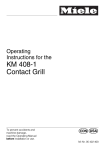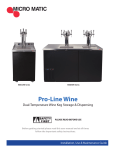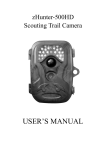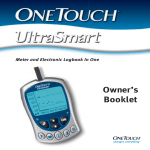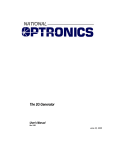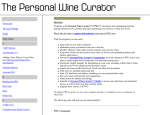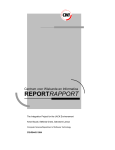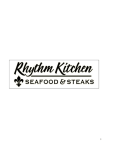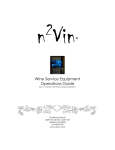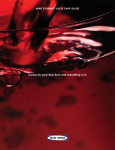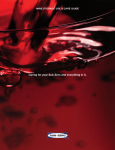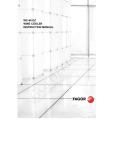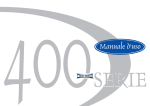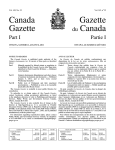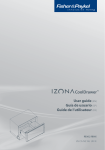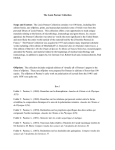Download Wine Service Manual
Transcript
WINE SERVICE PRESENTING THE LIST Every table in the tavern and MDR is approached with a wine list. Hand the list to whomever reaches/asks/seems most interested or is clearly the host; otherwise leave it on the table for anyone’s use. When leaving it, let the guests know that the list contains not only bottles, but glasses, half bottles and magnums, as well as after-dinner wines, spirits, specialty cocktails, non-alcoholic options and beers. WHEN SOMEONE ASKS FOR A “SOMMELIER: Do not be offended, and do NOT insist on trying to help them yourself, though you may be perfectly equipped to handle their needs. Get a SUIT , i.e. any manager. It doesn’t need to be “the beverage director”, nor do should you get into “explaining that she is not here but…” Like you, the entire management team started on the floor at GT and has been steeping in wine education for years here, so you can feel confident that the guest’s and your needs will be taken care of. Give that manager any hints about what the guest might be looking for. Likewise, if someone asks you a question that you do not have an answer for, go get an answer or a manager to act as the sommelier. With the system that Danny put in place here back in 1994 and that we have maintained since, we are essentially teaching you to be your own sommelier here, hence all of the hands-on, nose-in organic sort of ongoing training. Soak it up and let it give you confidence. You are learning more than you realize, and most guests are looking mainly for affirmation about their choice being a good one, not so much deep discourse on a wine’s history or a 10-year vintage review of Bordeaux. Read your tables’ needs and act and react accordingly. Your friendly confidence is often all that is needed to get exactly the wine our guests will enjoy drinking. ORDERING: Look at the 86 list to make sure that we have the bottle . Hint: know by heart the printed 86 list going into service. It makes you look smart & saves guest (and you!) a headache if you can tell them immediately that their chosen bottle is not available. Hint: a running list of new 86’s will be in a cup on service bar. Look at it every trip to the bar. Then look at the low list to see if it is the LAST bottle. Tell the guest that it is the last bottle when presenting it. Guests are generally grateful for and impressed with your supplying this information; conversely, they can be upset upon finding out after finishing the first [and only] bottle. Bottles are listed in appropriate Micros category alphabetically by PRODUCER name. The italics is NOT the producer name. 95% or the time it is a vineyard name or a proprietary name (in rare cases, it is the appellation name). Wines with a * on screen & dupe are kept in cellar or beer cooler. Includes all sparkling; very high-end whites; very high-end reds; older or more fragile reds; all Gamays plus other wines that drink better cool; wines that don’t sell frequently. Hint: The * kicks that wine to the top of the Micros screen, separating it from the rest of the wines on that page, but alphabetizing it w/ other * wines. Hint: * wines must be retrieved by a manager, which will be told to us by the service bartender ultimately, but you can speed up the process by telling the first manager you see that you are ringing in one of those wines (or vintage beers). Always modify the bottle with position number, so that anyone can present and serve the bottle if necessary.. Look closely at dupe : you might see any of the following: Type of glass to use A “D” to cue suggestion of decanting to you and the guest. “CHS’CLOTH” to indicate that the wine MUST be decanted with cheesecloth & funnel. 1 A * which indicates the bottle is NOT behind the bar and must be gotten by a manager “FUNKY” to clue you into being not a wine for everyone! Inspect label closely for producer, vintage & vineyard/other info to make sure that you have been given correct bottle. You must do this before getting to the table—often the info is in very small print and/or on back label. Do not get caught with wrong bottle or with being unable to point out & verbalize the details tableside. GLASSWARE: See notes starting on page 7 for general glassware notes. Remove unnecessary glassware from table. More than 2 bottles ordered at same time: ask the guest at that time if they would like both served at once or in sequence. Do not put down red wine glasses if they are waiting to drink the red. Keeping the tabletops comfortable and aesthetically pleasing is a priority. Check DUPE and glassware CHART for correct glasses (in pocket on wall facing coffee station). If someone else is putting down glassware for you, make sure that you double-check correct glassware and communicate that clearly. Bring polished glasses. You are not required to use a tray if you can carry them comfortably and securely upside down by their bases (we can teach you how). Place each glass at top-right of setting, just left & toward center of table from water glass (where white wine glasses are set at beginning of service). Multiple glasses per guest: picture a diagonal line from left of water glass toward center of table. First glass to be poured into is on the right, closest to water glass. Gracefully nudge water glass a tad to right if need be to accommodate line-up. Exception: these rules change completely when guests bring in multiple bottles to taste side by side and in flights. Here we switch to professional tasting protocol, by which you taste from left to right in a straight line, and front row to back row. This holds true even if there are only 2 bottles in a flight: those 2 glasses go at 11:00 and 1:00 above the plate. PRESENTATION: Before getting to the table, find producer name, wine name and vintage on the label. Get comfortable with the pronunciation of key words. Ask for help on this please (and see bev sheet if it is a wine by the glass since pronunciation clues will be there). Carry the bottle through the room and to the table cradled against your forearm with label facing outward, NOT by the neck or with label inward. You may carry a bottle this way in each arm; more than two bottles requires a tray. Present bottle to guest from the right side (where the wine glass is set). Exception: from left on seats where we do no service from right (ex: 1 on 233 or 1 on 142). Exception: from left when it would be clearly less intrusive (read body language). Verbalize producer, wine name & vintage to the guest, indicating each on the label (which at times will mean turning the bottle over or pointing out miniscule print). More than one bottle to present: bring one at a time from wine table. It is difficult to point at the label with two bottles in your hands. Temperature: behind bar we keep 2 of most reds at room temp and 1-2 of each white chilled. If a guest request cellar temp for any wine normally stored behind bar, a manager will bring one up for you. Modify it in Micros (key is on liquor prep screen). If the wine is normally kept at cellar temp(which you will see when you go to order it in Micros and find it with a *), tell the guest when you present the bottle. Our cellar temp is 50 degrees in case anyone asks you… If the wine is normally chilled but just came up from the cellar, you MUST let the guest know when you present the bottle--some will choose a different wine, while others will be satisfied with your offer to pour a touch for everyone to begin with and to place the bottle in an ice bucket for chilling. 2 Hint: ice WATER chills a bottle most rapidly. If there is nothing but ice in your bucket, pour water from a pitcher into the bucket. Sitting bottle ON ice does nothing, and in just ice with no water does little! Offer to decant when appropriate. Do not decant without discussing with guest first. Read every dupe that comes up with your wine: there will be a “D” for “decant” on second line of ticket. This means that decanting is advisable. Some whites will show the “D” as well: that tells you that some aeration from decanting and/or some warming up on the table (in bottle or decanter) will benefit this white. The “D” is a clue for you to suggest one or both to the guest. OPENING: If you have presented the bottle, you must be the one to open and serve it. SPARKLING WINES: See notes on page 4. All bottles are to be opened at the appropriate wine table (MDR) or the harvest table (tavern). You need a coaster, a black wine napkin and a tasting glass (use unpolished glassware, either an aromatic or sweet or fortified glass). Remove entire capsule, a.k.a. foil. EXCEPT when there is a paper tag stuck to foil & bottle: Italian DOCG wines & a few others have tags that cannot be removed cleanly, so in that case, just neatly cut the foil under the lip in the classic manner. EXCEPT for Champagnes, which have a pull tab. See sparkling wine notes on page 4. Remove cork. Waxed corks: do not try to remove wax first. It makes a mess, takes time and is completely unnecessary 99% of the time. Pierce it w/ corkscrew and drill right in, stopping periodically before pulling cork to thoroughly wipe off loosened bits of wax from the neck and lip. There should be nothing that can fall back into bottle after cork is out or that might get poured out from lip into glass (that said, it is FINE for there to be solid wax still on lip). For troublesome corks: for soft, crumbly or stuck corks, use the Ah-So (in the wine tool drawer across from the kitchen entrance). Get one of us to show you how. It’s a brilliant tool to whip out at the first sign of trouble. Smell /taste every wine: this is a must. You are playing your own sommelier, the person who traditionally provides that service. We consider it an imperative step in hospitable service, but it is an unusual one, to have waiters tasting wine—just be aware & let us know if any guest has questions. Use an unpolished glass, pour a very small splash, and smell/taste to check bottle’s soundness. If you have any doubt, second and third opinions are very helpful. It is crucial that that tasting pour for yourself is miniscule. If you want to save & come back to it, put it on a coaster or it will disappear. Flawed bottle: ring in another of the same and let manager/bartender know that you need it right away. Use your discretion about whether or not to let the guest know the situation. Hint: if any serious delay is likely, DO let them know. Hint: if they saw you tasting & then not serving their bottle, you MUST let them know Hint. If they neither saw you nor are going to be much delayed in receiving their wine, don’t share. Just open the new bottle & serve. No need to get them concerned about condition of the perfectly sound bottle you are pouring for them. That information will just be a distraction. Split flawed bottle off of check. Write “corked” (not “comp”) on that dupe and put it in the cup on service bar. Put sticker (in folder across from service bar) on bottle to indicate status. A manager will “void no waste” that bottle and make sure that it gets to JP’s desk in order to be accounted for in our inventory and possibly credited or replaced by the purveyor. No need to smell the cork. Its condition has little to nothing to do with the condition of the wine. Leave wine table clear of all debris, including tasting glass (take to kitchen after serving the wine). 3 DECANTING: SEE NOTES on reasons for decanting on p.5. Look at EVERY dupe for the “D” indicating a need for decanting BAR: you have no dupe. Learn the basic standards below & then ask a manager or senior staff on a case-by-case basis. Starting point of standards for decanting at GT: Reds over $100 (except for most Pinot Noirs/Burg & some non-tannic reds) AND/OR Reds 5 years and older (except for most Pinot Noirs/Burg & some non-tannic reds) Vintage port (or any other port sealed w/ a cork, not just a stopper) We always decant: Brunello; Barolo; Barbaresco; Amarone; Sagrantino; Taurasi. Two decanter sizes in house: one for 750’s (the majority) and one for magnums (only 2 of these). You may re-use decanters for 2nd bottle of same wine as long as they are sediment-free. Technique: take the decanter in one hand and the bottle in the other. Tipping the bottle gently, hold its “shoulder” above the candle flame, close enough to see through the glass but not close enough to blacken the glass. If there is any sediment, you want to see it as it approaches the shoulder and slow down to catch it in the curve of the shoulder. If the shoulder is too thick or dark to see through, then try the neck, knowing that you then have to be doubly careful about sediment, which will be on the verge of dumping into the decanter by the time you see it in the neck. Pour wine slowly & smoothly; adjusting your pour to avoid the “glug-glugging” effect that rushes sediment in a wave up from the bottom. As soon as any sediment starts to appear, gently continue, STOPPING at the point just before sediment would pour into the decanter. End goal is clean, sediment-free wine in the decanter and minimal wine left in the bottle. When to use funnel and cheesecloth: 95% of the time, you should not need or use them! Normally, the sediment will be distinct and collected in the bottom of the bottle, thus easily held back and left in the bottle if decanting is done carefully. DO NOT STOP MID-DECANT. This stirs the sediment up and and the decant will not be as clean. The 5% is when heavy sediment starts to appear well before end of the bottle. GENTLY set the bottle down and get the funnel & cheesecloth from the hutch drawer. Layer inside of funnel w/ generous amount of cheesecloth and place it in the mouth of the decanter. Then VERY GENTLY pick up the bottle and continue decanting. Hint: look at the dupe: ideally it will have had CHEESECLOTH indicated. Hint: please let manager or JP know about a sediment-filled wine that had no indication! You must still pour very gently and use the candle when decanting your bottle through cheesecloth (not on service bar for vintage port or decanted WBG). Why? Because even a funnel & cheesecloth will not necessarily catch all of the most super-fine sediment. Once you get to sludge in the bottle, don’t dump it into the funnel/cheesecloth. Just stop and leave that in the bottle instead of risking dirtying up the now-clean wine. There is little need for funnel with no cheesecloth—really mainly with a white where the cork crumbles into the bottle—then you obviously need to strain out the cork an just the funnel will do—but if it’s an old red, there is likely going to be sediment as well as the cork crumbs, so the cheesecloth is advisable then anyway. Remember, much decanting is done to open a wine up and not because of sediment. So don’t be surprised if you see that “D” note on your dupe and then find no sediment. “Double-decanting”: most guests won’t ask for this, but if you hear the term, it refers to pouring the decanted wine back into the [rinsed-out] bottle, which aerates the wine for a second time. 4 POURING: If serving a decanted wine, first set decanted bottle on coaster on table. Decanted magnum bottle: use MDR bread plate instead of coaster. Bring to the table all at once: bottle or decanter, black wine napkin and the cork on a coaster. Cork on coaster goes to right [or on serving] side of taster. Present all closures except for screwcaps. Includes corks with cages (sparkling); glass stoppers; and plastic or other artificial corks. Pour a generous mouthful of wine into taster’s glass, twisting bottle slightly at end of pour & wiping lip/catching drip w/ wine napkin. Label should face taster as you pour. Stand by with bottle label facing the taster, paying close attention to taster’s reaction. If bottle is rejected: see notes on page 5. If accepted, pour for the table: Start with first woman to left of taster. Continue clockwise, pouring for women first, then men, then taster last (regardless of gender). Twist bottle slightly at end of each pour & wipe w/ wine napkin to avoid drips. Label should face guest for whom you are pouring. Hint: learn to pour with both hands (practice w/ water)—it makes for much more fluid, nimble, sophisticated service—this way you avoid backhanding, a big no-no here at GT. Size of pours: our by-the-glass full pours are TOO HIGH for bottle pours for any wine. Aim between a 3-oz taste and the full 5- or 6-oz pour, erring on lower side. We are conservative in our pours unless guest requests or pour for themselves otherwise. White wine: ask if taster prefers it kept on ice or on the table. If on ice, write table number in discreet spot (ideally on back label) & place in bucket. If on table, remove cork and place bottle on coaster at center of table. If bottle is staying on table, cork goes into your pocket and the wine onto that same coaster. If bottle is not staying on table, remove cork and coaster (unless guest asks to keep/starts playing with cork). COMMUNICATION is imperative: servers & bartender must share every detail of wine service variances with teammates and managers. No detail is too small to share. Ex: guest wants a short pour only; or no more; or to pour themselves; or to not have a refill until glass is totally empty; or to wait until entrées; and so on. PLACEMENT OF BOTTLE (and DECANTER): Guest comfort/preference is paramount! Regardless of what is said below, if guest wishes to keep bottle or decanter at table, find a way. Otherwise, here is the deal: For decanted wines: MDR 4-tops (when they are sat with 4 guests): do NOT leave the decanter. Only leave the empty decanted bottle, though use your judgment and do not leave it if the table is too crowded and guests cannot even pick up their glasses ** DO NOT just walk away with full decanter: you must indicate to guest that you are setting it off to the side for their comfort. All other MDR tables including 4-tops sat with fewer than 4 guests: leave decanter + empty bottle on coaster. REMOVE empty bottle as soon as decanter has been emptied. Tavern tables: same rules as above. But even 2-top tabletops can be tight, so offer to bring the decanter to the harvest table if so. For full bottles of wine: they stay on the table, unless there is no space, such as on a full MDR 4-top. Please let guest know if you think it advisable to keep their bottle on a wine table. They virtually never say no and it is much easier to serve & dine at that table with no bottle to work around. LABEL FACES toward the taster, unless someone else is clearly interested, in which case turn the bottle in that direction. If you want to save the bottle for label removal, leave it on a coaster on a wine table or on the shelf across from service bar or it will get discarded. 5 REPLENISHING: Do not allow wine in glass to fall below half of original and appropriate pour. Our conservative pours mean that you have to pay close & constant attention to pour levels. Think hospitality: guest anxiety over when and where replenishment is coming from is not hospitable! If any guest wishes to pour own wine/keep at a low level/have no more, alert your teammates & managers immediately, so that we do not commit a faux-pas in trying to help. Black wine napkin in opposite hand whenever pouring! Do not leave poured-out bottles on table or in buckets. Saving label is an excellent way to extend hospitality & surprise our guests! UNFINISHED: by law, guests may take away an opened bottle IF they have ordered food and IF it is corked & sealed inside a secure bag (in cabinet across from service bar) with 2 copies of their receipt: 1 in the bag and 1 stapled to the outside. No exceptions for unopened bottles or for wine opened without food. If the guest does not want the remainder, bring it back to service bar. Let a manager know so that it can be priced & listed at service bar to be sold as “open wine” or possibly become a shift drink option. REMOVE EMPTIED GLASSES PROMPTLY. ORDERING/SERVING 2nd BOTTLE of SAME WINE: Taster only receives new glass (unless table requests all new glasses or you see that glasses are notably dirty). Pour into taster’s new glass (do not remove it or old glass until emptied. Pour into guests’ original glasses. If the first bottle was cold and the second is only cellar temperature, let the guest know before opening the bottle, so that they can decide on whether to change wines or have the bottle chilled first or neither. SPARKLING WINE SERVICE: Same steps except: Whole capsule is not removed: pull neck tab, peel it away and then remove top part of capsule. Loosen the cage by untwisting the wire, all the while with opposite hand holding a wine napkin with some pressure over the top of the bottle. Hold bottle at 45-degree angle. Add serious pressure with the hand/napkin over cork, holding that end of the bottle firmly still and then gently twisting the bottle, NOT the cork. As the cork starts to ease out, maintain pressure on it to keep it from flying out or popping loudly or wine spraying. The goal is silence, or at most a “whisper”. Keep bottle tipped at 45-degree angle until you see that the wine is not going to foam up out of the bottle; this angle generally prevents it from happening. Cork and cage are both presented. Initial pouring into each glass must be very slow, until the bubbles settle down and allow you to speed up a bit. Pour in a thin steady stream; goal is not stop-start-stop-start. PROPER POUR is not 5 oz, i.e. a full wine-by-glass pour. It is lower, closer to the 3 oz pour. . GLASSWARE: FLUTES ARE STANDARD but BE AWARE that we suggest some wines be served in white wine glasses instead. That is indicated on the dupe as “ww gl”. As with decanting, this glassware suggestion is just that, not a requirement for these wines, which are the fuller, more vinous styles of Champagne which are less about the visible bubbly effect witnessed in the flute than about the actual wine in the glass. Since the wines where this is called for is of nature that typically more savvy drinkers will order them, most who order them will appreciate your savvy in offering, whether they take you up on it or not. Don’t be surprised when guests ask you for flute alternatives for other wines too—it is not uncommon in this day and age of sophisticated wine drinking. 6 HOW TO HANDLE REJECTED BOTTLES When a guest refuses a bottle, our priority must be to make the guest feel comfortable with this decision. Never challenge the guest. The immediate goal is to politely gather information to help in selecting the next bottle as quickly as possible. If the guest simply did not like the wine, bring the list right away so that another wine may be chosen. If the guest thought that the wine was flawed and wants to try a second bottle of the same, then out of sight, re-taste the bottle. Get a second or third opinion if you have any doubt. If it is flawed (which ideally would have been caught before serving it), then feel perfectly comfortable in bringing another of the same wine to the table. Apologize for the error and serve that second bottle. If the bottle is NOT flawed and they want another bottle of the same wine, this is a slightly delicate situation. The guest is not going to like the second one better and we don’t want to waste it or the guests’ time in getting an acceptable wine to the table. Enlist a manager’s help in both tasting and going back to the guest if you are uncomfortable with it. The message is that the second bottle is going to drink much like the first one, which was typical of that particular wine, so another choice would be more to their liking. After the guest is tended to, remember to split that bottle off of check & affix a sticker on it. If it is sound, return it to service bar and a manager will decide what to do with it. CORKAGE For 750’s and 375’s: 1st-4th bottle: $35/bottle 5th bottle and beyond: $50/bottle ($50 from 1st to last bottle in the PDR) For magnum: $60/bottle ($85 in the PDR) We allow guests to bring their own wine, no questions asked, even if it’s on our list. We prefer to be informed ahead of time but do not require it. Ours is a very liberal policy. Any guest bringing wine in the door should ideally be told about corkage by the maître d’. But sometimes the guest does not make mention of it and ends up at your table pulling out bottles. This is not a problem but does require you to check with the door right away to see if the guest was told up front. If so, you do not need and should not mention it again. If not, then you need to gently inform the guest. Get a manager if there is any issue. If you know the guest to be a GT regular, in the industry or a VIP of any kind, check with a manager before mentioning and/or charging corkage. There are cases where we will suspend or discount the corkage fee. If you end up with one of those cases, please make sure that notes on corkage policy for that particular guest end up in their Open Table notes. We break the $35 corkage charge into a $10 gratuity and a $25 wine sale and the $50 corkage into $15 gratuity and a $35 wine sale. DO NOT CLOSE YOUR CHECK before a manager executes this adjustment. We cannot fix it once the check has been closed! 7 DECANTING: WHENS & WHYS There are two main technical reasons for decanting a wine. One is the possibility of sediment, which is tied to both the age of and grapes in a wine. In red wine, sediment forms when tannin molecules that were dispersed in the wine’s youth begin to re-bond, thus getting heavier, and literally drop out of the wine. Likely suspects for sediment with age include Cabernet Sauvignon, Nebbiolo and vintage Ports; runners-up are Sangiovese, Syrah, Merlot and Cabernet Franc (the latter two particularly if from Bordeaux); rarely does Pinot Noir throw sediment. Sediment ranges from chunky to fine and silty. Chunky is easier to hold back and keep from pouring into the decanter. Fine sediment requires a more careful hand and keen eye over the flame. If it lies at the bottom of the bottle, it is generally not a problem to hold back. If, on the other hand, the sediment is suspended throughout the wine or down the inside of the bottle, that is another story. If the wine has been stored on its side, some hours standing up can solve the problem to a degree; but if the wine has been stored standing up already, decanting the wine through cheesecloth and funnel is the only possible solution (and may not work perfectly). The second technical reason to decant is to soften and open up a wine for immediate drinking. This is particularly helpful for young tannic reds whose time is coming a little earlier than it ideally should. Instead of evolving and mellowing in the bottle for some more years, it gets a quick blast of oxygen as it tumbles into the decanter, plus the time sitting in the decanter with that large surface area exposed to the air. This instant “maturation” of sorts does not replace biological aging but does help to open up a closed wine. The two reasons to decant explained above would appear to apply to, and typically does apply mainly to, red wines. But there are plenty of whites that can benefit from decanting. At times, there are actual crystals in the bottom or in the neck—these are usually tartaric acid molecules that have re-bonded—an occurrence generally confined to unfined, unfiltered whites that most likely have dropped in coldtemperature storage at some point after leaving the winery. Cold causes those wonderfully natural acid molecules to behave that way. Like tannins, tartrates are absolutely harmless, just visually or texturally offputting. Most whites have no such visible need for decanting, but some more powerful whites (ex: some Burgundies, Austrian Rieslings and skin-fermented whites, aka “orange” wines) can be tightly wound and will blossom with a gush of oxygen. Look for the “D” on your dupes for these whites (as well as the reds). This will all make more sense with experience. A third and non-technical but no less important reason to decant, mainly reds in this case, is the expectation of it at a certain level of wine and/or restaurant. Decanting is associated with fine dining. It suggests elegance and fineness and thus makes people just feel good sometimes. In the case of most wines on our list, which is not heavy on really old, fragile wines, decanting will do no harm; it is mostly a matter of whether it will help it drink better or not and whether it will thrill the guest to have it done for them. Older wines past their prime will suffer from decanting. That sudden exposure to air after years in the bottle can send a wine that is already on the edge right over the edge. We rarely have such bottles on our list, but guests do bring them in and in those cases generally will have strong opinions on, though occasionally will seek our advice on, whether or not to decant them. Final points on decanting: wine connoisseurs and collectors who are our guests tend to have very firm ideas on the topic. This applies particularly to their own wines brought in for us to serve them. Decant or don’t according to their wishes. Don’t filter the wine through funnel or cheesecloth without their permission. Filtering wine in this manner at all (funnel, cheesecloth, coffee filter, etc) is a moderately controversial topic amongst wine pros 8 GLASSWARE There is a chart of proper glassware broken down by sections of our wine list. It lives in both the wall pocket above the Micros terminal closest to the coffee station and in the bar notebook. In many cases, whole sections of our list will go in the same glass. For instance, all Pinot Noirs (including red Burgundies) and Nebbiolos are served in Burgundy bowls; and all Merlots, Cabernet Francs and Cabernet Sauvignons in Bordeaux glasses. But there are many exceptions to the whole-section-in-one-glass concept, mainly in the “assorted white” and “assorted red” sections. Always look at the dupe when you order a bottle. If no glass indicated, then you know to check the chart and that it’s in one of those one-glass-fits-all sections; if a glass is indicated, then there is your answer. Of course for wine bottles sold to bar guests, there is no dupe to consult—in those cases, check the glassware chart and if need be, ask a manager or senior staff member. Occasionally, you will see some of us vary from the prescribed glassware. If you think that your wine might warrant an exception, just check in with a manager for advice. There is a method to the madness, though it may seem mysterious at first. As you get to know the nature of various grapes and wines, the likely and correct glassware choice will start to become instinctive. Below is some explanation of the choices: 1. FLUTES: for most sparkling (Exception: Bordeaux glass for Lambrusco. Exception: white wine glasses for certain Champagnes (see notes on sparkling wine service on p.5) 2. AROMATIC: for Chenin Blanc, Viognier, Scheurebe, Riesling, Gewurztraminer, Pinot Gris & Muscat. The last 4 are the noble grapes of Alsace (but rule applies even for non-Alsatian versions!) if that helps you remember. All benefit from the flare of the rim, which sends their aromatic perfume billowing forth and which leads the wine to hit the palate in such a way to accentuate sweetness (if it is in fact a sweeter style, which is not always the case). 3. WHITE: for virtually all other whites and rosés (Exception: white Burgundies over $100). 4. BURGUNDY Gamay, Pinot Noir (including Red Burgundy), Nebbiolo and Northern Rhône Syrah. Used for the more aroma-driven, light-to- medium-bodied reds. The generous bowl allows aromas to blossom yet be contained. 5. BORDEAUX: Cabernet Sauvignon, Merlot, Cabernet Franc, Sangiovese, Syrah (non-northernRhone), Grenache, Mourvedre, Tempranillo & Zindandel. For the more medium-to-full-bodied, tannic reds, the more “sturdy” wines. 9 WINE-BY-THE-GLASS PROGRAM The wine-by-the-glass (WBG for short) list is the heart of our wine program. Think of it as a snapshot of the larger list. Once you are familiar with these 30+ wines, which is the most basic of expectations of you as a Gramercy Tavern server or bartender, you have go-to’s all over the bigger wine list! There will always be 4-5 sparkling wines, 2-4 rosés, 10-12 whites and 10-12 reds, across a range of grape varieties, countries, styles and prices. Each section is organized from lightest-to-fullest-bodied (hint: just like our beer lists!). On average, a wine or two per week will change, never all at once, much like the food menus, which shift gradually with the seasons and newly available products. The beverage sheet gives you many details on each wine, packed into a very small space. The most recently added WBG will be in boldface. You are required to know at a minimum: the grape(s), appellation where relevant, the italics where they exist (always either a vineyard name or proprietary name, as with full-bottle list), vintage and the region/country of origin. The rest of the story on each wine on the bev sheet is for you to absorb and share with your guests at will. Have fun with it all and ask more questions if you have them! Written info will only get us so far. In addition to knowing the facts, you must be able to articulate the basic nature of the wine, as well as pronounce all parts of its name reasonably correctly. We encourage you to taste the wines regularly, either as shift drinks or at service bar. Don’t bring a wine to a table if you have never tried it—having already read up on it on the bev sheet at family meal, you need to stop and take a few seconds on the way to the table to taste the wine. BASICS: PRICING Glass price is always the full-bottle price divided by 4 (5 in case of sparkling). All WBG wines are listed by the bottle as well in appropriate categories. POURS Full pour is 6-oz (or 5-oz. for sparkling wines). Tasting pour is 3 oz (including for sparkling wines). GLASSWARE Proper glassware rings up on 2nd line of dupe. All whites & rosés in white wine glasses. Reds in either Burgundy or Bordeaux glasses. All sparkling in flutes (except for red Lambrusco) ORDERING Wines are alphabetical by producer on Micros screen (as with full bottles). Order with a position number. Do not group glasses of same wine together. Ring each seat’s drink in order & separately. MDR: bottle comes up on service bar to be poured tableside. TAVERN: wine poured at service bar unless you modify “do not pour”, which you will do when: It is the 2nd glass of same wine—you should take bottle and re-fill at the table. You want to taste the guest on wine(s) to help them decide. CHECKING BOTTLE Is it sound or flawed? Either service bartender or server needs to check each newly opened bottle! 10 SERVICE Presentation is abbreviated vs. bottle presentation: display label & verbalize “Lagler Riesling” for example, as opposed to the full “Lager Riesling Federspiel Spitzer Setzberg 2008” as you would if serving it by the bottle. Black wine napkin in your non-pouring hand to catch drips always. Pour a sample taste and await guest’s response. Pour to correct level: this is a CRITICAL POINT OF HOSPITALITY. There is an excellent chance that more people than just you will be pouring at your table. You do not want guests to have occasion to be uncomfortable about inconsistency of pours. BEWARE: Price sensitivity/”blind” orders: if guest asks for “a glass of Cab”, without looking at the WBG list, and our only one is $18, then you need to make sure that they are aware by either opening a list and pointing out the wine and drawing your finger across to the price OR by verbalizing something to the effect of “great, we have the beautiful Corison 2003 from Napa Valley for $18”. Exceptions only for guests whom we know very well and whose expectations are known to us. Taste/glass price ”mix-ups”: occasionally, a guest will order a full glass, thinking that its price is the 3-oz price. You will not know that until you drop the check. More often than not, we will honor the mistake, but please let a manager know immediately if this is happening. Challenges to pour level: if guest disputes level of pour, let them know in a friendly manner that “this is our standard __oz. pour”. If they are aggressive about it, you can offer a splash more, while pleasantly making it clear that this is a one-time exception once only; this is not the ideal solution but may feel necessary to avoid a seriously sticky situation. Regardless, you need to let a manager know the instant that the WBG pour level becomes an issue with a guest. HOSPITALITY/SALES 3-oz. tasting pour—this option, which we take for granted, often astounds guests. When presenting the WBG list, verbalize the option to them. The half-glass can be quite seductive for those going light, or who are curious about a few wines or an off-beat wine, or who have finished their bottle but have a little food left on their plate. Excellent opportunities to enhance their experience (and the check) abound. Try guest on more than one wine--if guest expresses interest in more than 1 wine, offer tastes to help them break a tie. Ditto if they are curious about but afraid to commit to something outside of their comfort zone. Do this in both Tavern and MDR as time permits. This extra gesture truly delights our guests. Saving labels—as with bottle labels, presenting the WBG label to take home can surprise and please our guests. Check in with the service bartender for help procuring an empty bottle. PAIRING WITH TASTINGS We do not pre-set wine pairings for our tasting menus. This makes pairing slightly more challenging for new servers but overall a lot more fun, since you can take into account the guests’ budget, preferences and willingness to experiment (or not), as well as your own favorites (which might include beer or spirits or dessert wines, not just dry wines). Taste, taste, taste. The fluidity of the pairings does necessitate your being on top of what we are pouring. AND to not hesitate to call on managers and experiences peers for advice as needed. Please ask, as we are all eager to share ideas, especially as you build your confidence. Whether or not to taste guests on your suggested pairing or just pour: this is a matter of judgment and experience (over time and with your individual tables). There is no hard and fast rule. Some guests will want to audition & discuss every wine; others will completely trust you and expect you to just pour. Be prepared to explain the reason for your choice, while bearing in mind that some guests want a little and some are eager for the full “show”. Timing: paired wines should arrive either just before or with the next course. Guests should not be waiting for you with food in front of them. 11 COMMUNICATION: if you are working as part of a captain-waiter team at dinner, you MUST stay in touch about pairings, particularly what is NEXT in the line-up. There will be times that someone besides the captain needs to jump in with the next wine. Open bottles to sell: most of the time there are bottle-only wines to sell by the glass. Check the service bar for the list in case there is something interesting to throw into the pairing mix. 12 AFTER-DINNER PROGRAM The after-dinner menu is packed with a wide variety of sweet wines, fortified wines and spirits. Such a range of options beyond the standard “glass of Sauternes” or “glass of Port” or Sambuca is fairly unusual, so take advantage of it to put our guests’ experience over the top! As with our wines by the glass, we encourage you to taste anything and everything on the after-dinner list. It takes time to learn its ins and outs, but it is time and energy well spent. This menu comes to the table after every meal along with the dessert and cheese menus (or by itself in the case of tasting menus). Please verbalize its presence to your guests. Your enthusiastic suggestion of a favorite sweet wine to go with desserts/cheeses or a digestive spirit after the meal can be an easy sell. Or surprise them with something as a comp. Few diners think to treat themselves to or even think of an aftermeal drink. We all tend to think of extra food first to add value to a meal, but with a little creativity on you part, the burden on the kitchen and guests’ full stomachs can be eased with the after-dinner list instead! DESSERT WINES: This includes all sweet wines, Ports, Sherries & Madeiras—in other words, the entire first two pages of the after-dinner list. Pricing: glass price is full-bottle price divided by number of glasses: 4 for 375 ml ; 5 for 500 ml bottle; and 8 for 750 ml bottle. Ordering: There are two screens: 1 for sweet wines & 1 combining for Ports, Sherries & Madeiras. Wines are alphabetical by producer on Micros screen (as with full bottles). Sweet wine page is organized by country: starts with new world and ends w/ old world, ending w/ France (hint: same pattern as you’ll find on the regular wine list in the sections where countries of origin are mixed). Each wine is listed by grape or appellation, producer name coming second. Italics are for vineyard or proprietary names. *Beware: there are many like-sounding choices in Port, Madeira & Sherry. “Taste” option in Micros gives you a half-size (1½ oz.) pour. Whole bottles: there is a Micros key to lead you to the whole-bottle screen. If the wine is also offered by the glass, the whole bottle needed will be upstairs. *If the sweet wine is bottle-only, then it will need to be brought up by a manager. ALWAYS order with a position number. Pour: 3 oz. Exception: 6-oz. pour in aromatic glasses for Moscato d’Asti and Perrone Bigaro Exception: tasting pour: 1.5-oz (handy for comps and stuffed but interested guests!) WHERE the pour happens: MDR: tableside always: Use your judgment re: tasting them on wine before pouring. For ex: if you are pairing throughout the meal and they have been routinely going with your suggestions without tasting first, then you can probably skip the tasting step here. Otherwise, taste them. Tavern: service bar unless rung in & modified “do not pour”. By all means, pour at the table if guest is curious or unsure (*just like w/ WBG). If you wish to pour something yourself tableside, simply modify it “DO NOT POUR” Glassware: Proper glassware rings up on 2nd line of dupe. To learn by heart: “Sweet wine glasses” are the flared-edged ones that resemble our aromatic glasses in miniature: these are used for the “white” wines on the sweet wine page. “Fortified glasses” are the straight-sided, taller ones: these are used for red wines (not all technically are fortified wines) on the sweet wine page and for all Ports, Sherries, & Madeiras (which are all fortified). 13 OTHER 3-oz. pours: Ordering: there are special screens for the categories below. Vermouths, Quinquinas & Americanos: Glassware: varies, see dupe How served: some stored chilled, some not, see dupe (and request otherwise if needed) Poured: at service bar for both MDR & tavern (make an exception by ringing “do not pour”) Vins de Liqueur: Glassware: fortified glass How served: chilled Poured: at the table for MDR, at service bar for tavern Common denominator above & below for 3-oz pours: alcohol level around 18-20% (like Port, Sherry & Madeira) so you can think of it that way and/or look at the label. SPIRITS: There are two sides to our spirits program. One is the specialty side, what we are mainly talking about in this section, considered to be everything that is actually printed in the menu; the other is the non-specialty side of more commonplace spirits (like Dewars or Bombay or Sambuca). Specialty spirits Broken down into many categories on the after-dinner list. Any spirit listed on the menu is found on one of these specialized Micros screens. Any spirit not listed on menu is found under “server liquor” in alphabetical category. (Ex: Baileys under “liq a-e”; Jack Daniels under “liq f-o”; Sambuca under “liq p-z”) Ordering Always with a position number. Modified if needed on the liquor prep screen Pour size: 2 oz. POURED AT BAR for both MDR & Tavern All whiskeys (white, rye, bourbon, Scotch, Irish), gins, rum, tequilas If you wish to pour something yourself tableside, simply modify it “DO NOT POUR” POURED AT TABLE in MDR & at bar for Tavern: All amaros, specialty (listed) liqueurs, brandies (eaux-de-vie, grappa, Calvados, etc) Glassware: proper glassware rings up on 2nd line of dupe. Amaros: cordial glass (*temporarily using sweet wine glasses) Grappa, marc, eaux-de-vie: cordial glass (*temporarily using sweet wine glasses) Other brandies (Calvados, Cognac, etc): snifter Specialty liqueurs: varies between cordial glass or snifter Whiskeys: determined by how guest orders it (neat, rocks, ROCK,splash of water, etc) Listed Bourbons, listed Scotches, Negronis & Manhattans ordered “on the rocks” are automatically served on THE ROCK. 14














